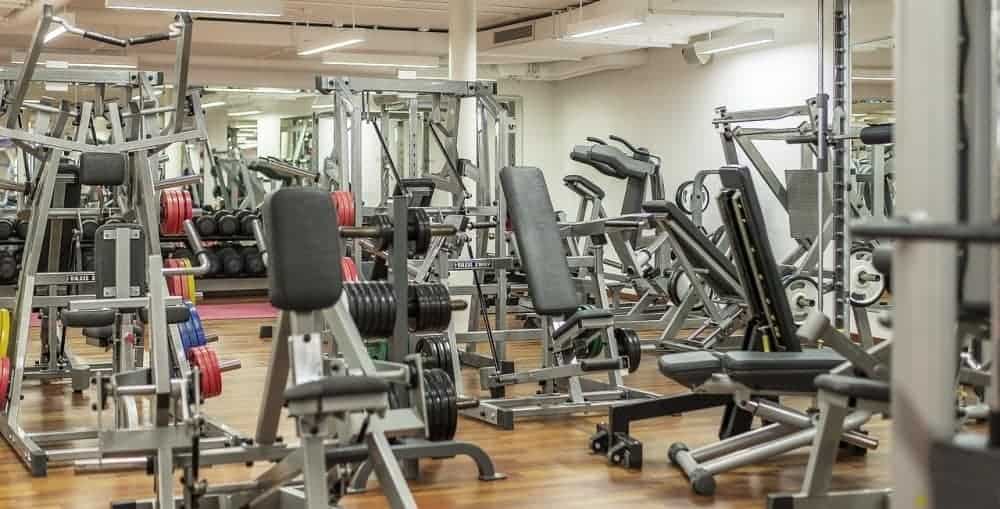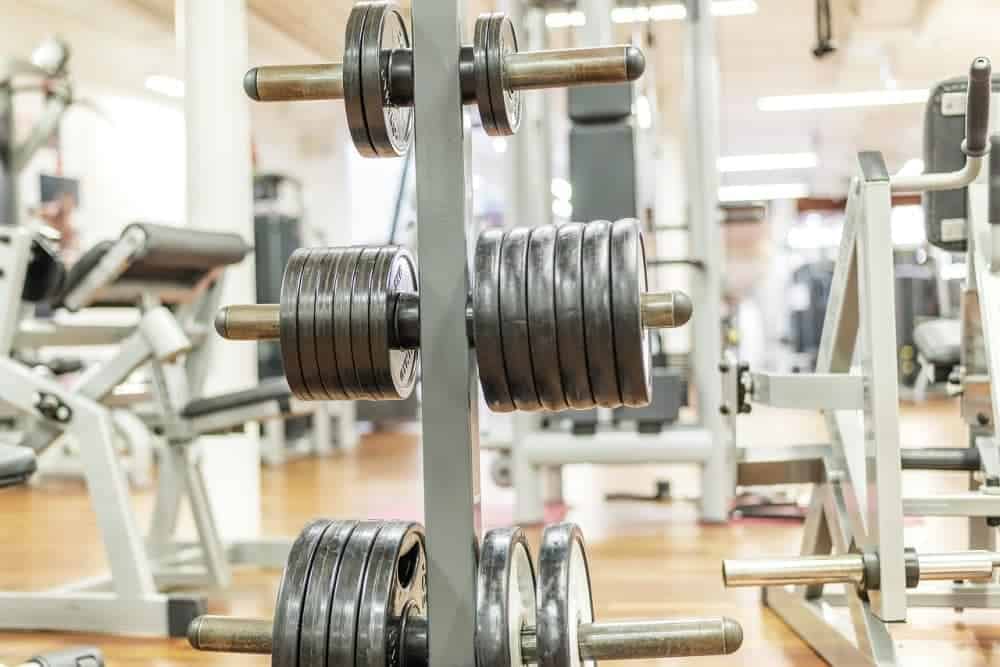The full-body exercise plan is the ideal entry into strength training and is also quite suitable for a diet.
It is one of the simplest but best forms of strength training for beginners.
Whether you want to look better or lay the foundation for bodybuilding, training the whole body several times a week stands out through its time efficiency.
In addition, you can concentrate fully on improving your technique and develop a clean execution.
Even for advanced and professionals this type of training can make sense on various occasions.
However, particularly when doing full-body you must always keep an eye to properly align the volume to your conditions.
In contrast to classic split training, the entire body is trained once in each training session.
This means, on each training day, ideally, chest, back, shoulders, legs, arms and optionally your abdominal muscles should get targeted.
What advantages this training concept brings along and what such a plan looks like will be further discussed in this article.
Eventually, I’ll give you a free training plan that you can implement!
What is a Full-Body workout actually?
Basically, in a full-body workout, your entire musculature is trained during each training session.
Unlike “split” training which is focused on only specific muscle groups per session (for example, chest and biceps or back and triceps).
Lastly, there is the alternating full-body workout, which is slightly different from the conventional one. Although you train the same muscles in each workout but with different exercises and varying loads for individual muscles.
Which training plan is the right one for you? How many times a week?
You can only free up two times per week to hit the gym?
Then the conventional full-body workout may be the better option for you.
Do you want to train 3 times a week?
Then the alternating full-body workout proves to be a very efficient concept to get stronger while building muscle mass with relatively small frequency.
Unsure how to best train for your individual goal? Check out our blog with massive content or reach out and contact us through our social media channels.
Advantages of a full-body workout
This strength training concept did not gain popularity without reason. Full-body workouts have a couple of benefits that I’ll address in this section.
Movement patterns are rehearsed
Especially for beginners, it is very important to learn the correct technique to execute each exercise cleanly and safely.
This works best when having a selection of a handful of exercises in your program, rather than many different exercises that vary with every training session.
Relatively little stimulation needed
In the beginning, your body will react to literally everything which means you don’t need a huge volume or intensity to start off.
If you’re just starting over, your body will benefit from every single rep and set that you haven’t done prior.
Think about it.
Pretty logical, right?
If you haven’t held any dumbbell throughout your entire life, every additional rep is a new stimulus, right?
Furthermore, your muscles do not need extensive regeneration time yet, so it makes sense to load each muscle group more than once a week.
Therefore, particularly beginners benefit from almost everything, granted that you obey proper technique and execution.
Unfortunately, too many people, and I number myself among, still go to the gym without having a clear plan about the exercises and how to do them.
I made the exact same mistakes back in the days when I started working out. Watching a short tutorial before each training session, varying exercises for no reason and not having any clue about proper technique.
Anyhow, this seems to be somehow unavoidable since I consistently see incredible bulks of people who think they are exercising their chest but actually only their front delts.
And this is just one example out of hundreds…
Therefore, I really enjoy whenever I can give other people some hints and tips around training and nutrition because you certainly don’t need to make the same mistakes and save the trouble.
Having said that, all these articles are meant to provide you with all the things I wish I’ve had known back then.
Full-body workout burns many calories
With a full-body workout plan, the focus is usually on basic compound exercises that involve multiple muscle groups at the same time.
The more muscle parts involved, the more muscles are activated and supplied with energy which respectively leads to higher energy expenditure (= higher calorie consumption).
For this reason, such a plan is wildly popular in the weight loss field.
For whom is the full-body workout suitable?
As already mentioned, a full-body program is especially suitable for beginners who have not previously trained according to a structured plan.
Learning the exercises should always be in the foreground to train not only injury-free but also correct and effective.
Nonetheless, this workout is not only ideal for beginners, but also for those who simply want to stay fit. Training the entire body drives you the beads of sweat into your face which also promotes your cardiovascular system.
Needless to say, serious muscle building is definitely viable with this concept.
Advanced athletes, however, usually prefer a 2-split or 3-split, because with the increasing frequency (for example 5-6 times a week), the body cannot keep up with the regeneration, if each day of training is concentrated to the entire body.
The configuration of a full-body workout
How could such a training plan look like?
In the following, I’ll consider all the important variables, such as exercise selection, rest times, frequency and intensity so that you can get an impression of what you have to keep in mind when using a full-body workout plan.
Exercise selection
Since we have to train the entire body in every training session, we cannot incorporate 3-4 different exercise for each muscle group. That would simply take way too long and overload the body.
The following guidelines can be useful for you when designing a full-body workout:
- Select 1-2 exercises per muscle group
- Focus on basic compound exercises (for example, squats, bench press, deadlifts, pull-ups, etc.)
- Avoid isolation exercises
Why avoid isolation exercises?
To put it simply, it does not make sense to incorporate many isolation exercises as part of a full-body workout, as they work primarily on small muscle groups separately and disregard the supporting muscles.
The goal is to develop a feeling for your musculature and most importantly learn the basic exercises, which occur in almost every workout program.
Frequency – How often is it advisable to train weekly?
Basically, as beginners, I would advise you to perform a full-body workout 2-3 times a week. Four times tend to be too much whereas only once is too little.
Overload and underload are things that you want to avoid when striving for effective muscle growth.
If you want to train three times a week, I can generally recommend an alternate full-body plan, which unlike the conventional full-body plan has different exercises and varying loads on each training day.
You can also start with the conventional full-body plan three times a week, but then make sure to change as soon as your regeneration capacity is not sufficient anymore.
How many sets and reps?
For beginners, a higher repetition range of 10-15 reps per set may a good way to start your weightlifting journey, as with lighter weight it becomes easier to obey and rehearse the correct technique.
As soon as you feel halfway safe in the execution, you can also increase the weight slightly and do fewer reps.
If you run the plan twice a week, orientate yourself around 3 sets of 8 reps for each exercise.
If you decide to choose three times a week, then I would rather do 2 sets of 8 reps each.
This is because the training frequency (how often) correlates negatively with the training volume (how many: sets x reps).
If you increase on one variable, the other sinks.
Before each exercise, warm up yourself adequately. This not only reduces the risk to injuries but also boosts your performance.
Rest times between the sets
That is quite different from exercise to exercise. Heavy compound exercises like squats require more recovery time than biceps curls.
Basically, you can remember the following rule of thumb:
The more the exercise demands and the more muscle groups are involved, the longer the breaks should be.
- Basic compound exercises: 2-3 minutes
- Other multi-joint exercises: 1-2 minutes
- Isolation exercises: 1 minute
The breaks between each set should be as long as you need to finish the next upcoming set with clean technique. As a guideline, 2-3 minutes are sufficient.
The stronger you get, the longer the rest breaks will get. Obviously, it’s not possible to lift your 1RM for 5 sets with merely 30-45 sec in between.
However, especially for beginners, the rest breaks should be no longer than 2-3 minutes. In this particular stage, your muscles don’t need such extensive regeneration.
Nonetheless, this can vary individually. When you feel fresh again, start your next set.
If you notice that you cannot keep up with the recovery, you may want to assess whether other parameters such as sleep and nutrition are optimal adjusted.
How much weight to start with?
If you have never moved weights before, start with squats and deadlifts with 50% of your body weight.
For bench press, rowing and shoulder press, start with 30% of your body weight.
Be aware that a conventional 220cm long barbel usually weighs 20kg alone.
For pull-ups, you have to start with your body weight. In week 1 try to perform only one set of 8 reps.
If you only manage 4 reps, take a short break and do another 2 reps. Repeat this until you achieve your total of 8 reps.
The next week you try this with 2 sets of 8 reps. You will see after a short time you can then perform 2×8 or even 3×8 pull-ups in one go without additional breaks.
Progression
The key to success in any form of training is progression. In this case, either by increasing the weights and/or sets and reps.
As a beginner, you can increase the weights very quickly. Not uncommonly even from workout to workout.
Once you have completed all the required sets with clean technique, increase the weight at the next workout.
As a guideline, +5kg for leg exercises, +2.5kg for the smaller muscle groups.
A full-body sample workout plan for beginners
The following training plan is designed for beginners and should be adjusted over time with increasing experience.
Training plans are always individual and adaptable to each and everyone, so there is no such thing as a universal plan.
Thus, it is important to understand this plan rather as a basis and adapt it to your own individual needs.
Needless to say, it is important that you train all muscle groups in one session.
Biceps and triceps are already demanded through the other exercises, particularly the back (biceps) and chest (triceps) exercises, so you do not have to isolate them separately for now.
Do not be afraid to add exercises that turn out to be fun for you. Even it seemingly does not make that much sense at first glance.
The joy of training is important for maintaining your motivation.
This sample workout plan for beginners can be used around 8-12 weeks or even longer.
After that, it can be quite useful to exchange some exercises or, if you don’t feel at ease with full-body workouts, switch to a split plan.
Full-body sample workout plan:
- Squats for 2-3 sets x 8-15 reps
- Bench press for 2-3 sets x 8-15 reps
- Deadlifts for 2-3 sets x 8-15 reps
- Shoulder press for 2-3 sets x 8-15 reps
- Rows for 2-3 sets x 8-15 reps
- Pull-Ups for 2-3 sets x 8 reps
Closing thoughts
The full body workout is the ideal entry into strength training.
Frankly, all newcomers should train for the time being on such a plan to practice technique and develop a better feeling for training and their muscles, rather than starting with a 3-split just because most big guys do so.
Each and everyone started small. The full-body workout certainly provides you with a great foundation from which you can further improve.
In addition, it is also suitable for dieters, as the focus on basic compound exercises burns many calories.
Both in a diet or bulk phase, you should pay attention to sufficient protein intake (around 2g per kg body weight).
Especially beginners are not used to the increased protein inputs. In such a case, I can recommend supplementing whey protein. On the one hand does this supply your body with the required proteins to convert your efforts into muscles and on the other hand even saves calories, if you are on a diet.
I hope you enjoyed this guide about the full-body workout for beginners.
If you still have any question feel free to reach out to me.
What is your personal experience with full-body workouts?
Share your opinion in the comments below!
Thanks for reading, guys
Cheers,







